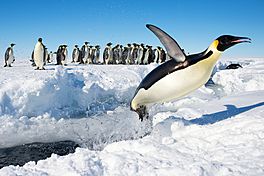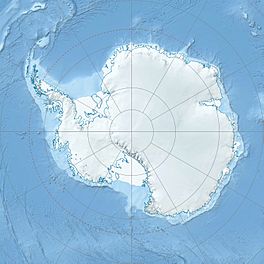Stancomb-Wills Glacier facts for kids
Quick facts for kids Stancomb-Wills Glacier |
|
|---|---|

Emperor penguins breed in the IBA
|
|
| Type | cirque |
| Location | Coats Land |
| Coordinates | 75°18′S 19°00′W / 75.300°S 19.000°W |
| Thickness | unknown |
| Terminus | Weddell Sea |
| Status | unknown |
The Stancomb-Wills Glacier is a very large glacier in Antarctica. It flows into the eastern part of the Weddell Sea, which is a big bay. This glacier is located south of Lyddan Island.
Contents
Discovering the Stancomb-Wills Glacier
The Stancomb-Wills Glacier was first seen from a U.S. Navy LC-130 plane. This happened on November 5, 1967. The United States Geological Survey (USGS) then used photos from that flight to map the glacier.
The name "Stancomb-Wills Glacier" was given in 1969. It was named by the Advisory Committee on Antarctic Names (US-ACAN).
The Stancomb-Wills Glacier Tongue
The Stancomb-Wills Glacier Tongue (75°0′S 22°0′W / 75.000°S 22.000°W) is a long part of the glacier that sticks out into the sea. It's like a giant icy tongue reaching into the eastern Weddell Sea.
This icy tongue was first found in January 1915. A British expedition led by Ernest Shackleton discovered it. Shackleton first called it "Stancomb-Wills Promontory." He named it after Dame Janet Stancomb-Wills, who gave a lot of money to help fund his expedition.
In 1969, the US-ACAN changed the name to "Stancomb-Wills Glacier Tongue." This change happened after the U.S. Navy flight discovered the main glacier. They then understood how the tongue was connected to the larger glacier.
Stancomb-Wills Glacier Important Bird Area
The Stancomb-Wills Glacier Important Bird Area (74°06′15″S 23°05′31″W / 74.10417°S 23.09194°W) is a special place for birds. It covers about 352 hectares (which is about 870 acres). BirdLife International has named it an Important Bird Area (IBA). This means it's a very important spot for birds.
This area is important because it is home to a large group of emperor penguins. These penguins come here to breed and raise their chicks. In 2009, satellite pictures showed that about 5,500 emperor penguins lived there. They live on the fast ice, which is ice that is frozen to the coast. This special breeding spot is on the north-eastern side of the glacier tongue. It is about 60 kilometers (about 37 miles) west of Lyddan Island.
See also
 In Spanish: Glaciar Stancomb-Wills para niños
In Spanish: Glaciar Stancomb-Wills para niños


